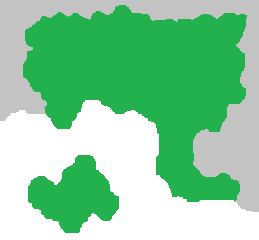Cartulia
Republic of Cartulia Republika Cartulia | |
|---|---|
| Motto: "Anorfod." "Immortality." | |
| Anthem: "Danza de Dawi" "Dance of the Dawi"[1] | |
 Map of Cartulia. | |
| Capital and largest city | Alcazr |
| Official languages | Cartulian |
| Recognised national languages | Iblesian |
| Ethnic groups | 97% Cartulian, 3% Other |
| Demonym(s) | Cartulian |
| Government | Parliamentary Democracy |
• Presendentor President | Torm Cevanto |
• Presmismo Minastentor Prime Minister | Jorg-Alvor d'Ladron |
| Independent (Sovereign) | |
| 1058 CE | |
| 1067 CE | |
| 1674 CE | |
| 1881 CE | |
| Area | |
• | 308,011 km2 (118,924 sq mi) |
| Population | |
• Estimate | 78.2 million |
• Density | 253.9/km2 (657.6/sq mi) |
| GDP (PPP) | 2022 estimate |
• Total | ¢449,259,000,000 |
• Per capita | ¢57,450 |
| GDP (nominal) | estimate |
• Per capita | ¢58,000 |
| Currency | Eschanta (E) |
| Date format | dd.mm.yyyy |
The Republic of Cartulia, shortened to Cartulia, is a sovereign state located in western Ishr. It has a population of approximately 78.2 million people according to a 2023 Census, of whom the majority (97%) belong to the indigenous Cartulian ethnic group. The capital city, Alcazr is located on the isle of Caditha and serves as the political and economic hub of the nation, with a population of 8.5 million it is also Cartulia's largest city. Cartulia shares a land border with Iblesia to the north, Kavo to the northeast, Trodenhiem to the east, and Promethia to the south. With a land area of 308,011 square kilometres it is one of the smallest nations in Ishr by land area, but also one of the most densely populated. Formed as a monarchy in 1067 CE, Cartulia became a Republic in 1881 following the Cartulian defeat during the Third Ishran War. Formerly a colonial power Cartulia officially surrendered the last of its overseas territories in 1956, but would continue to intervene militarily in its former colonies until the Ishran Court of Arbitration ruled further interventions illegal in 1989.
As of 2022 the total GDP of Cartulia was ¢449.26 billion, with the GDPPC stable at around ¢57,450. This makes Cartulia one of the wealthiest nations in the world. Furthermore Cartulia boasts a HDI score of 0.950, which has remained stable since 2018. Cartulia is a founding member of both the IECU and NIDA, and plays a significant role in regional politics and diplomacy.
Cartulia has a developed economy with strong engineering and technology industries, particularly in the areas of hardware development and manufacture. Alcazr is also a global economic and banking hub with a long history in finance dating to the early 15th Century. Since the industrial revolution Cartulia's economy has been developedwith a strong industrial base, initially fueled by the discovery of coal in the northern hill of Thaea; this allowed for the rapid growth of textile and steel production. The modern industrial economy in Cartulia is diverse, manufacturing various goods including cars, trains, ships, and aircraft. Otherwise the Cartulian economy relies heavily upon the oil and natural gas reserves located in the Kolthiraean Sea. The oil and natural gas industry accounts for approximately 19% of Cartulia's GDP and is one of the nation's largest employers.
After drawing criticism during the 1980s for its interventions in its former colonies of Ishval and Aramatheria Cartulia has faced accusations of human rights abuses and war crimes. These issues have damaged the nation's international reputation and have been a point of diplomatic tension ever since. Since the 1990s Cartulia has been the target for ethnic and religious extremist terrorism.
Etymology and Terminology
Cartulia takes its name from the ancient Dawi deity, Corto, who was the chief god in their pantheon. Corto also served as one of the genius loci for the isle of Caditha, upon which the Cartulian capital is located. Structurally the name is derived from the Dawi, in which Cartu is the possessive and lia translates to 'land', making the complete word literally; 'Corto's Land'.

